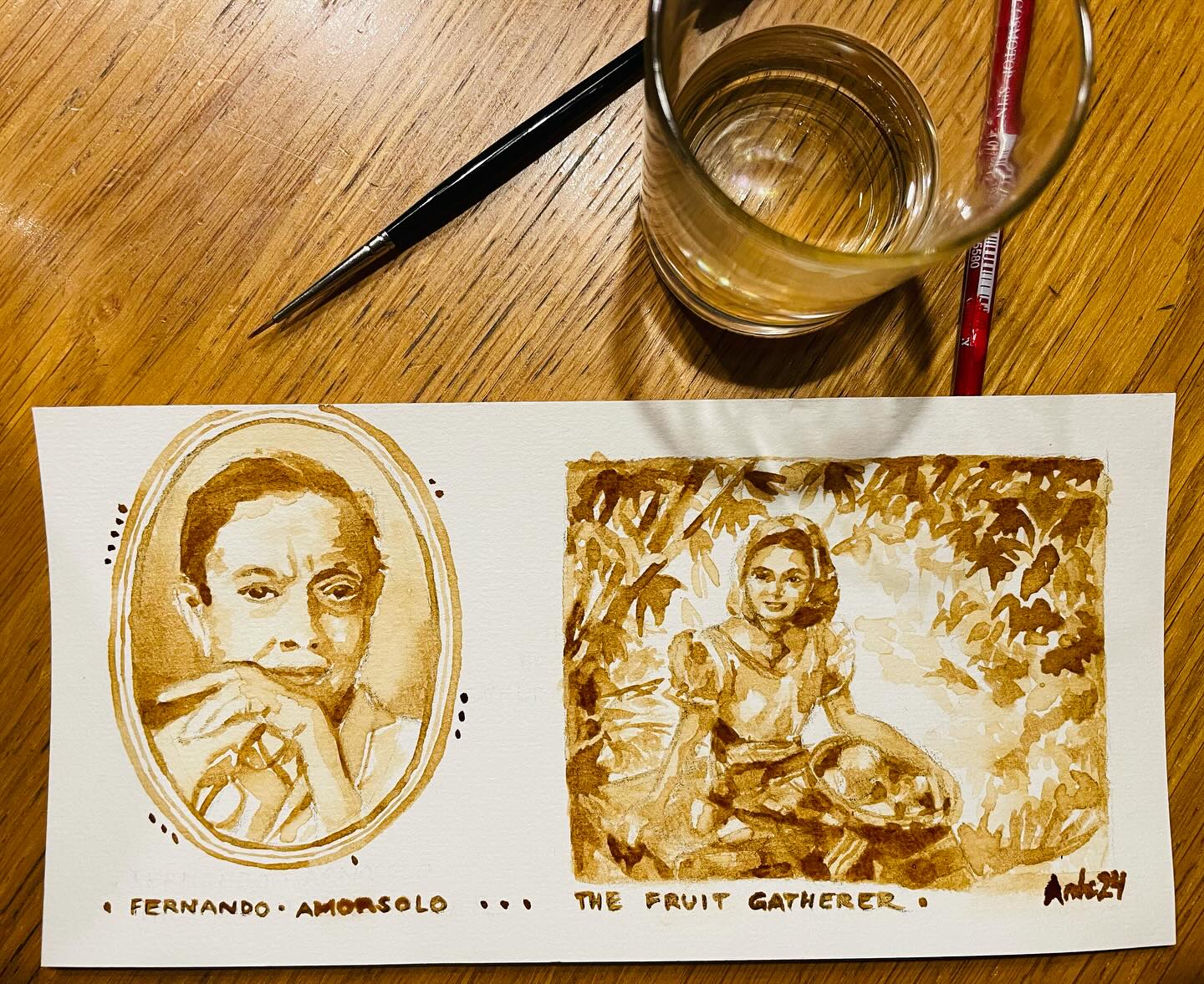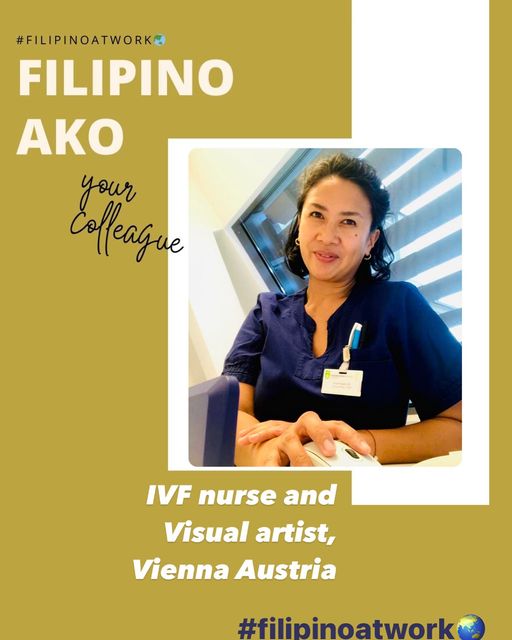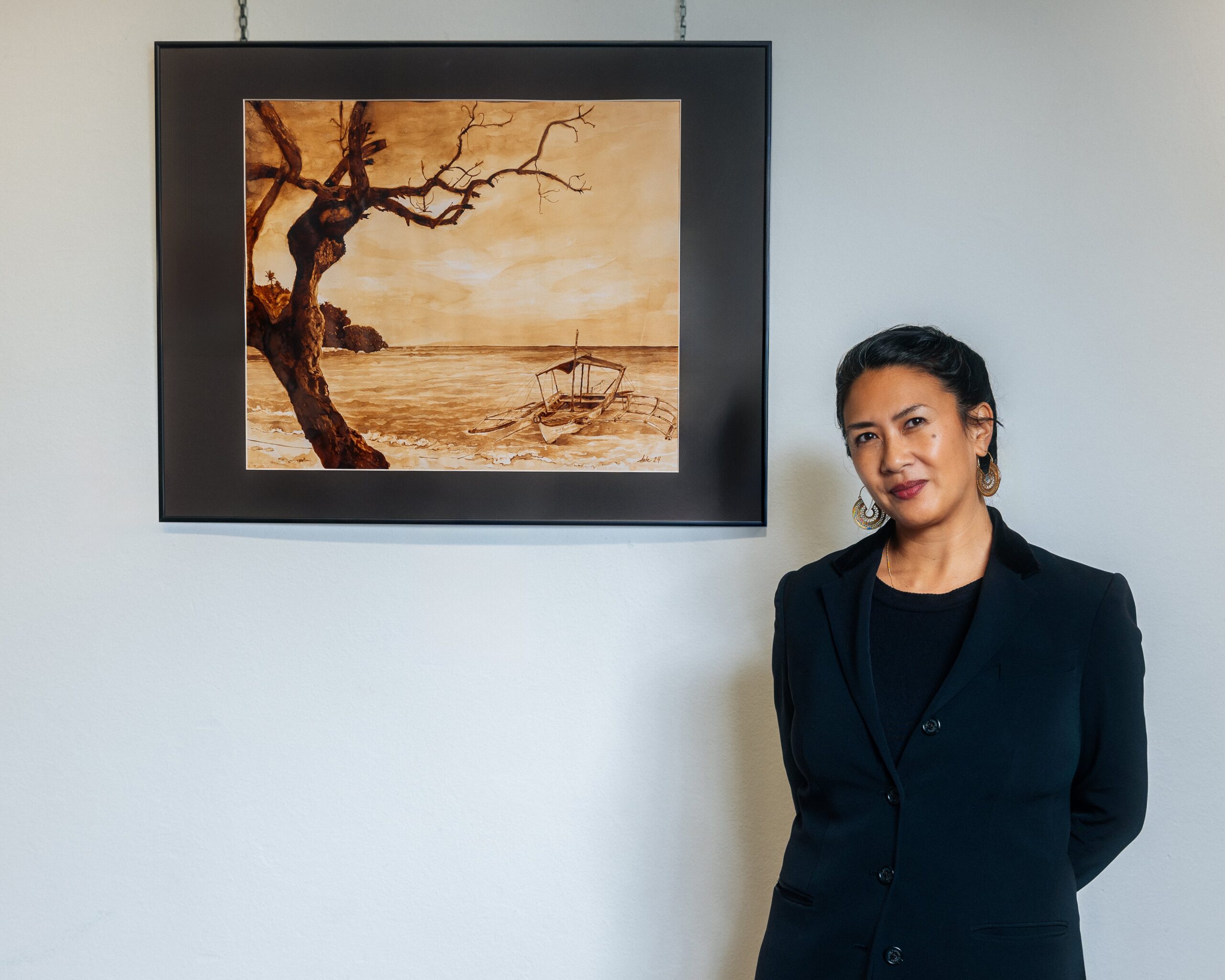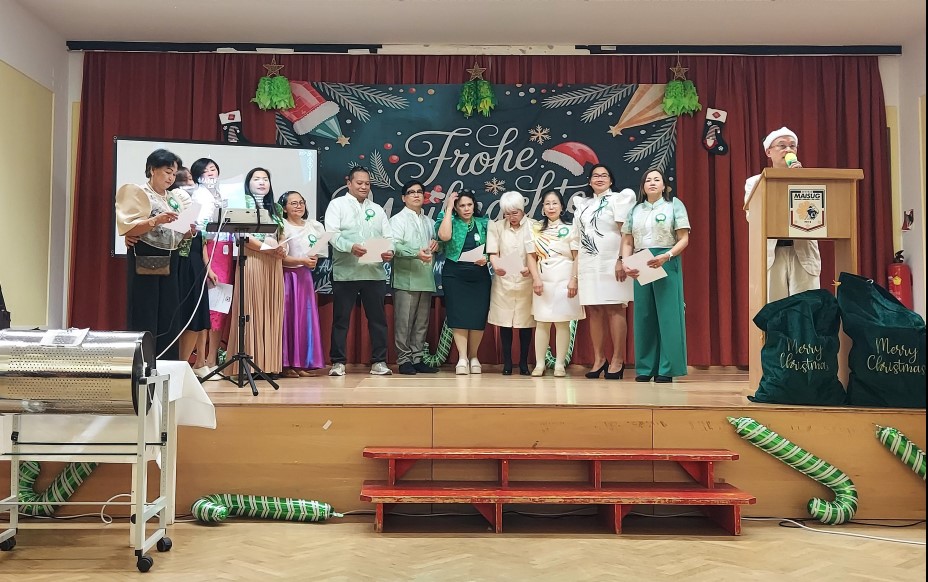In this interview, I had the pleasure of speaking with Lisa Pangan, a remarkable artist and dedicated healthcare professional based in Vienna. Lisa brings a unique blend of creativity and compassion to both her roles—as a contemporary painter and as the lead nurse at an IVF institute where she’s worked for over 15 years. Her artwork is distinctive for its use of gouache, a medium known for its rich opacity and versatility, as well as an intriguing experimental element: coffee. She uses these unconventional materials to bring texture and depth to her pieces, crafting visuals that evoke warmth, introspection, and connection.
Our conversation dives into Lisa’s dual career path and the balance she strikes between her art and her responsibilities in healthcare. She shares insights into how her work at the IVF institute influences her art and vice versa, reflecting on the parallels between nurturing life and nurturing creativity. Lisa’s journey is an inspiring example of how passion and profession can complement each other, and each brings an added dimension to the other. Join us as we explore the intersections of art, empathy, and healing in the life and work of Lisa Pangan.
Background and Inspiration
Austrian Press: Can you tell us a bit about your journey as an artist? What inspired you to start using coffee as your primary medium?
Lisa Pangan: I am a contemporary artist who enjoys working with gouache as well as experimenting with coffee in some of my pieces. My family and friends have always recognized my passion for drawing and painting, appreciating my artwork from the very beginning. I even structured my AHS Matura to pursue art studies, but ultimately, I hesitated to take that path and instead focused on my strengths in nursing, where I served as the leading nurse at an IVF institute in Vienna for more than 15 years. Painting has always provided me with balance in my life. During the challenging times of the COVID pandemic, I turned my focus to themes of sensory experience, identity, and belonging. I encapsulate these themes in what I call “Diaspora Art,” which resonated with others who share similar stories— essentially, I was discovered by the Filipino community in 2022.
Years ago, I met a Filipino artist in the Netherlands and was intrigued by his coffee paintings. This sparked my curiosity, and I wanted to learn more and try it myself. Until then, I only knew coffee as a beverage and possibly as a cosmetic.
Now, I am a recognized member of the artist group in the Philippines called “Sining Kape at Kultura,” led by Rens Tuzon. I represent this art here in Austria to help build bridges to Filipino culture. My teacher in traditional arts is Andy Nabong, and he is leading the Vienna Atelier of Traditional Arts in Vienna (VATA).
Austrian Press: How do you merge your Filipino heritage with your experiences in Austria in your artworks?
Lisa Pangan: I navigate my world primarily through observation, which has helped me find my way between cultures—sometimes more successfully than others. One thing I’ve noticed is that Filipinos are often not visible enough, usually represented only through stereotypes in various service roles. As a child and young adult, I longed for greater diversity in the representation of my fellow Filipinos, or “kababayans,” to guide my personal development and search for identity. My goal is to reach people who are Filipinos or who have Filipino migration histories with my art, showcasing the richness of our diversity. Having been born and raised in Austria, I’ve learned very little about the Philippines from here.
Through my art, I try to bridge that gap. For example, in one of my recent series of coffee paintings, I focused on Filipino masters and their works, such as Amorsolo, Manansala, and Botong, among others. I interpreted their masterpieces in coffee painting and created small portraits of them. With this tribute, I aimed to learn about Philippine art history myself and share that knowledge with people here, as there is a lack of awareness of Filipino artists in this context.
Austrian Press: Is there a particular moment or story behind your first coffee painting? What led you to this? unconventional medium?
Lisa Pangan: Gerry de Guzman, leader of a Filipino artist organization called “Filipino Visual Artists in Austria,” led a workshop on coffee painting. I discovered that this medium can be processed similarly to gouache. If you’re familiar with watercolour techniques, it’s quite comparable. I was able to incorporate coffee into my artwork immediately.
What fascinates me is the idea of integrating something so ordinary into an artwork, making art accessible and easy to engage with. I can paint anywhere there’s coffee; I just need to have paper and a brush on hand. I especially love how coffee painting, with its sepia effect, always evokes a beautiful sense of nostalgia. It’s something so unique.

Artistic Process and Technique
Austrian Press: Can you describe your creative process? How do you transform an idea into a coffee painting?
Lisa Pangan: I start by sketching my subjects with a soft pencil to establish the composition of my work. Then, I prepare 6 to 8 shades of coffee, creating progressively lighter mixtures by adding water to the dark base colour. When painting, I work in many layers. Sometimes, I have to wait up to 24 hours between steps. In terms of pure working hours, I need about a week to complete a 70×60 cm piece.
Austrian Press: What challenges do you face when working with coffee as a medium, especially compared to traditional paints?
Lisa Pangan: Coffee painting could be challenging because water reactivates the dried coffee. This means that areas that aren’t fully dried can be smudged or even erased completely. Creating paint from ground coffee is quite labour-intensive and can also become expensive. Instant coffee can be used as a substitute, but the difference in colour is noticeable; brewed coffee yields a nutty brown hue that is much darker.
Austrian Press: Do you experiment with different types of coffee (e.g., local vs. imported), and does that influence the texture or colour in your art?
Lisa Pangan: Instant coffee is very practical for quick enjoyment, and I like to use it in workshops. Different brands also vary in hue. My absolute favourite is brewed coffee that has been cooked down until it becomes a dark, almost sticky substance. I love its unique colour, and as an artist, I can experiment even more with its preparation. The shine of coffee in my paintings is achieved by how concentrated the application of coffee is in certain areas.
Austrian Press: How do you achieve the depth and variety of tones in your paintings using only coffee?
Lisa Pangan: I use 6 to 8 colour shades and 2 to 3 different types of coffee. Additionally, I work in many layers.
Austrian Press: Do you incorporate other materials or mixed media into your coffee paintings, or do you prefer to focus solely on the coffee?
Lisa Pangan: No, I want to push the limits of this medium and explore what’s possible. Sometimes I even use salt for special effects.
Themes and Symbolism
Austrian Press: What themes or emotions do you often explore in your work, and are they influenced by your Filipino culture or life in Austria?
Lisa Pangan: I grew up in two cultures. My surroundings were predominantly white and European when I stepped outside, while at home, I was immersed in a Filipino household. My parents believed that, as a child with a migration background, I would only have a chance to succeed in our new homeland if I exclusively spoke German. They wanted their children to thrive, coming from a working-class family. This strong drive to belong in Austrian society led to unintentional gaps in my connection to Filipino culture. It wasn’t until years later that I became aware of this and began to fill those gaps at my own pace and according to my interests. This has resulted in a hybrid culture, allowing me to be flexible and dynamic. I have developed resilience that enables me to seek out new experiences and discoveries.
I want to experience acceptance of myself and my strengths. I am enough just as I am. I am Filipino, even though I was born elsewhere and don’t speak the language perfectly. I am also Austrian, despite having two Filipino parents and being part of the second generation living in Austria.



Austrian Press: Many painters are inspired by nature, people, or emotions. What are the key motifs in your coffee paintings?
Lisa Pangan: I enjoy painting Philippine beaches or scenery using coffee painting techniques. The atmosphere in these pieces feels different, and the colours give them a sense of being from a “forgotten” time. When I create my gouache paintings, you’ll often find a lot of green. These colours reflect my memories of my father’s garden in Bicol, Philippines. I also love painting portraits. Many know me from the series “Farewell to the Unknown,” where I portray deceased individuals. I never paint them alone; there’s always a second person—usually obscured. My intention is to convey the feeling of farewell experienced by those living in the diaspora, who must part from loved ones without knowing when they will see each other again.
Austrian Press: How do you hope viewers in the Philippines and Austria interpret or connect with your art?
Lisa Pangan: I love listening to my viewers as they share what my paintings evoke in them or what memories they trigger. Engaging in these conversations makes me feel like I’ve finally found kindred spirits, regardless of their cultural backgrounds. I want to emphasize that diverse cultures enrich society. Fear of the unknown diminishes this richness. Through my art, I contribute to showcasing diversity.
Austrian Press: Does using coffee as a medium carry any special symbolism or cultural meaning for you as a Filipina artist?
Lisa Pangan: Coffee as a medium is an ideal way to bridge Filipino and Austrian (coffee) cultures. In my workshops, I draw on knowledge from both coffee cultures to create a connection. This allows people to connect through art and build relationships through creativity. This is my contribution to fostering better interactions among multiple cultures. I make Filipino culture visible while also showing that Austrian culture is welcome.
Austrian Press: How do you handle the balance between preserving your cultural identity and adapting to a new country’s artistic environment?
Lisa Pangan: I strive to be authentic and to learn continually. I enjoy sharing what I’ve learned with those who are interested and engaging in conversations to gain further insights. I was raised to resist being placed in a single box so that others could understand me. I make an effort to engage with both cultures and believe I’m succeeding in doing so.
Austrian Press: How do you continue to evolve as an artist? Are there any new techniques or subjects you’re currently exploring?
Lisa Pangan: I’m currently learning traditional art techniques from the old masters. This challenges my senses and skills, and I can see how it influences my other artistic directions. I enjoy observing my own development, and I’m grateful that others are excited to join me on this journey, even if they don’t paint themselves. I’m still at the beginning of my career as an artist, and I appreciate every milestone along the way.
Austrian Press: What advice would you give to young Filipinas or aspiring artists who want to explore unconventional mediums like coffee in their work?
Lisa Pangan: Even established artists wonder how to preserve coffee as a medium. They tend to prefer oil and acrylic paintings, which are known for their durability. However, what often gets overlooked is that artists from the past used natural materials in their paint mixtures, and those works have endured over time. With today’s methods, preserving art is much easier, and there are numerous products available on the market.
Austrian Press: Are there any collaborations or exhibitions, either in Austria or the Philippines, that you’re particularly proud of?
Lisa Pangan: In Austria, I have participated in several cultural events (Kubo, Wienwoche, Musmig, UrbanNomadMixes). What brings me even more joy is that my artwork has also been featured in magazines (Roots & Wings, Südwind). I take pride in this second career path that has opened up since 2022, and I find it immensely enjoyable. It’s a privilege to express my art, attract interest, and have it sold. Furthermore, I contribute something meaningful to society, and I’m able to embrace both cultures as I know them fully.
Austrian Press: What’s next for you? Do you have any upcoming projects or goals for your art career?
Lisa Pangan: I don’t have fixed goals, but I remain committed to what my heart desires. As long as my art has an audience, it will continue to be visible. When it’s time to move on, I will bow and step away.
Austrian Press: In what ways do you hope your art contributes to the conversation about cultural identity, migration, and belonging in today’s world?
Lisa Pangan: Diversity and variety are already being embraced, representing richness within a society. I want to contribute to this idea through my art. I hope those seeking answers will find them or at least feel a sense of safety. This is my way of sharing love and fostering better connections among people.
- pictures: Lisa Pangan/by Rob Detoyato
This post has already been read 2651 times!



